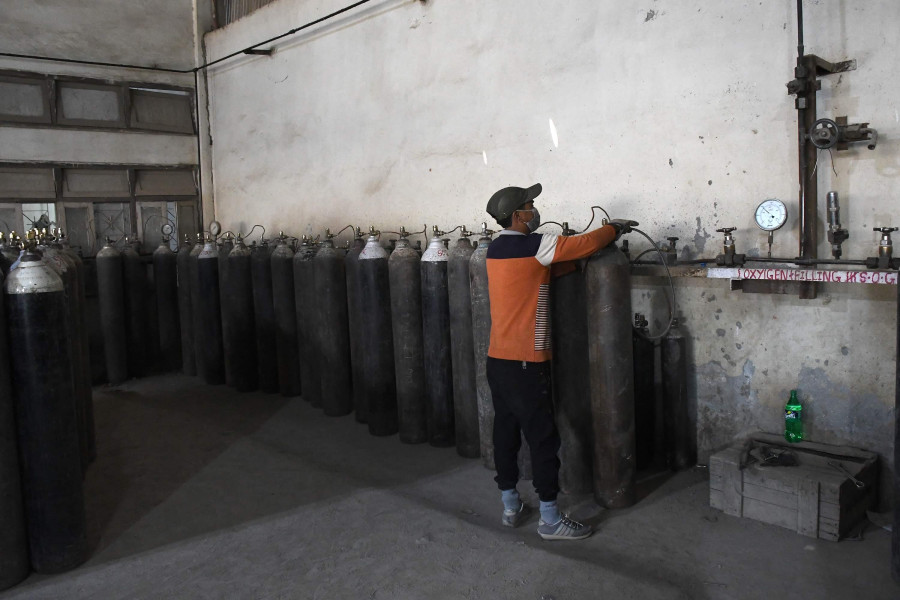National
No oxygen for households without doctors’ prescription, manufacturers say
Households with chronically ill and Covi-19 patients in home isolation are holding on to oxygen tanks over shortage fears.
Prithvi Man Shrestha
Oxygen manufacturers have started to restrict supply to individual households, citing the potential shortage of oxygen for patients as hospitals are overwhelmed with critical Covid-19 patients.
Despite a rising demand for oxygen from individual households given that most Covid-19 patients are self-isolating, the manufacturers said they are making it harder for individual households to access oxygen in order to ensure that hospitals don’t face a shortage of oxygen.
This is another attempt by the manufacturers to ensure that hospitals are supplied the life-saving gas after they suspended supplying oxygen to industries. According to the Oxygen Industry Association, industries consume around 30 percent of the total oxygen supplied in Kathmandu Valley.
“We have made it mandatory for individual households to produce a positive test report of Covid-19 and the doctor’s prescription that the patient is in need of bottled oxygen,” Shankar Lal Agrawal, managing director of Shankar Oxygen Gas, told the Post.
In recent days, oxygen plants have been receiving a rising demand for oxygen from both hospitals and individual households. While hospitals are running out of beds due to surging coronavirus patients, the number of people staying in home isolation is also increasing.
Nepal on Saturday reported 5,706 new cases of Covid-19 confirmed through polymerase chain reaction tests. As many as 40,103 Covid-19 patients are staying in home isolation, according to the Health Ministry data as of Saturday. As a result, the demand for bottled oxygen at households has soared, manufacturers say.
“We discussed with the Health Ministry what to do about the rising demand for oxygens from households,” said Gaurav Sharda, president of Oxygen Industries Association, a grouping of oxygen manufacturers based in Kathmandu Valley. “As per the consultation with the government, we have decided not to supply oxygen to households without doctor’s prescription.”
The manufacturers said that the demand for oxygen at homes was propelled by the rise in the number of Covid-19 patients in self isolation.
Households having chronic patients of respiratory issues are also demanding more oxygen. Manufacturers say the oxygen crisis in India has prompted the users in Nepal to have oxygen cylinders at their homes.
This perception has given rise to a situation in which people tend to hoard oxygen cylinders at home when hospitals need them for critically ill patients.
Before the latest surge in Covid-19 cases, the Balaju-based Shankar Oxygen Gas used to supply about 5 to 10 oxygen cylinders to households in a day.
With the rise in infections, the company is also seeing a substantial rise in demand for cylinders from individuals.
“Currently, demand for oxygen from individual households ranges from 100-150 cylinders per day,” Agrawal told the Post.
Many other plants in Kathmandu Valley have also reported an increased demand for oxygen cylinders. “Households used to buy 1 to 2 cylinders in a day from my factory but now there is a demand for 20 to 25 cylinders a day,” said Sharda, who is also the director of Kantipur Oxygen Pvt Ltd.
Similar is the experience of Shiva Prasad Ghimire, managing director of Everest Oxygen. “Households' demand for filled oxygen cylinders has grown several times. But I don’t have the exact data,” said Ghimire, whose own son, daughter-in-law and a grandson have fallen ill with Covid-19.
As hospitals are running out of beds for Covid-19 patients, there are growing concerns over a potential shortage of oxygen.
The Oxygen Industries Association has said around 6,000 cylinders of oxygen are being supplied to Kathmandu-based hospitals every day from their combined capacity of 8,000 cylinders. But surging cases of coronavirus infections have created doubts if oxygen would be available adequately even when the oxygen plants run to their full capacity. A limited number of hospitals in the country have their own oxygen plants but not all of them are operational.
According to the Health Ministry, out of 185 hospitals across the country, only 26 have their own oxygen plants. Hospitals like Tribhuvan University Teaching Hospital have been unable to maintain their plants for the lack of necessary kits.
In view of the potential shortage, the government has asked manufacturers to import at least 20,000 cylinders as soon as possible by exempting customs duty, value added tax and excise duty. But manufacturers say it is too late to call them to import cylinders for immediate needs.
“The best option for now is to airlift oxygen cylinders and the government should work towards flying in the cylinders,” said Ghimire. “Through the normal process, it will take time and many lives might be lost before they arrive.”




 6.73°C Kathmandu
6.73°C Kathmandu










%20(1).jpg&w=300&height=200)




